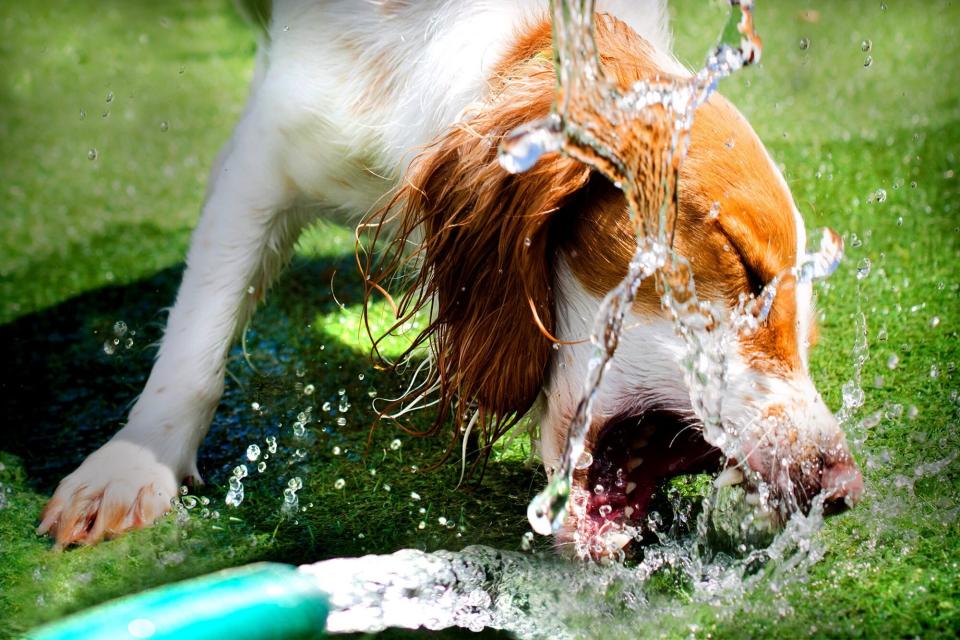Dehydration in Dogs: Causes, Symptoms, and How to Get Your Dog Rehydrated
You know it when you see it, or maybe, in fact, you hear it first: Your panting, tongue-out, dehydrated dog needs a drink after some fun playtime outside.
Getting your puppy rehydrated might be just as simple as refilling his water bowl, but if that doesn't work, it might be time to break out the ice cubes or chicken broth. (Seriously.)
Here's what else you need to know about dehydration in dogs, including, causes, symptoms, and how to get your dog feeling better again, courtesy of Michelle Moyal, DVM and lecturer in primary care surgery at Cornell University's College of Veterinary Medicine.
What Causes Dehydration in Dogs?
You'll find some of the same causes of dog dehydration as you will in cats. Moyal says:
Excessive panting from heat, exercise, or both
Loss of appetite
Conditions that make the dog urinate more, like a condition of the adrenal gland such as Addisons disease
In short, anything that causes fluids to leave your dog—whether through sweat, urine, vomit, or diarrhea—puts your dog at risk of being dehydrated.
"These are the things that your vet knows about because hopefully they see your pet routinely, and they can help … give you things to look for at home," Moyal says.
RELATED: How to Keep Your Pet Healthy All Year Round
Signs of Dehydration in Dogs and Puppies
There are three pretty obvious ones: vomiting, diarrhea, and panting. Dogs will pant when they're trying to cool off after exercise or wandering around outside when it's hot.
"Dogs don't really sweat like people do," Moyal says. "They have a limited amount of areas to sweat from, and so they try to release heat through panting. Panting increases the loss of fluid."
That's also your cue to make sure your dog has some fresh, cool water available. Like in humans, severe dehydration in dogs can have serious consequences, including death, if they go too long without water.
Another symptom for a dehydrated dog is dry gums. If you suspect anything, you can check to see if your pup's gums are moist and slick, Moyal says. If they're dry, your dog might be dehydrated. (Side note: If they're a different color than pink, call your veterinarian. A different color could mean your dog is having trouble getting the necessary blood or oxygen flow.)
Moyal suggests yet another way to check your dog's hydration: the skin turgor test. Gently gather up your dog's skin under his neck and between his shoulders, lift it up, and release it. The skin snapping back down is a good indicator that your dog is hydrated while the skin slowly descending could mean he needs more water. However, some leaner or older dogs might have their skin stay up even when they're hydrated.
Dog Dehydration Treatment
The first thing you should do if you think your dog is dehydrated is contact your veterinarian. They know you and your dog's medical history, so they can tell you exactly what to do in pretty short order.
"It can be really tricky, so I don't know if I would leave that in [the dog owner's] hands," Moyal says.
At the vet, your dog's physician and staff might even administer an intravenous (IV) drip to make sure the dog can get as many fluids as he can as quickly as he can.
But, if you're for some reason stuck at home or unable to get your vet on the phone, here's how to rehydrate your dog safely at home.

Busybee-CR / Getty
Dog Dehydration Home Remedies You Can Try
OK, the first thing you want to do is fill your pup's water bowl with cool, fresh water and make sure he can get to it. If that doesn't work, Moyal suggests adding chicken broth to the water to give it a little more of an enticing flavor. (You can also add the broth or water to your dog's wet or dry food to add extra fluids to his diet.)
What else can you try? Ice cubes!
"Some dogs will actually take the time to like [it] and crunch," Moyal says. "Some of them think of it as a treat even if they're not feeling great, so that's actually a very sneaky way to get water in."
Moyal recommends not feeding your dog hydration cures for humans (Gatorade, Pedialyte) because they might have too much sugar. While canine hydration supplements, like this one, exist, Moyal recommends sticking with water unless your vet recommends otherwise.
"To me, nothing is better than sneaking in just good, old-fashioned water," she says.
Preventing Dehydration in Dogs and Puppies
This will cover the basics first: Make sure your dog has access to fresh, clean water at all times. If you live in a chillier locale, make sure your dog's bowl doesn't freeze.
"The goal is to prevent it before it starts by just having the resources, right?" Moyal says.
RELATED: Hydration Station! Here Are the 13 Best Water Dispensers for Thirsty Dogs
That also means limiting your dog's activity outside when it's hot out. Make sure you bring enough water—for you and the dog—when you go for a long walk or hike. And remember: While you might've spent all winter on the treadmill, your dog didn't, do take it easy on them for the first few walks. They have to get in shape, too. And while we shouldn't have to say this, we will: Don't under any circumstances leave your dog in a hot car.

